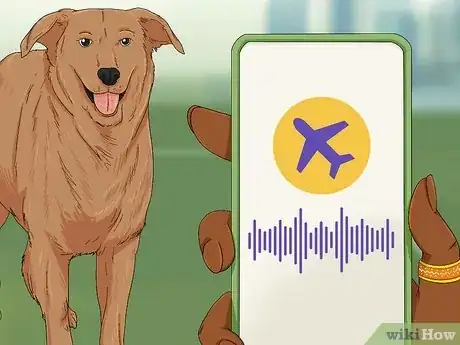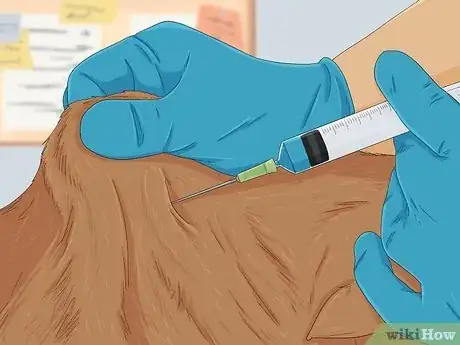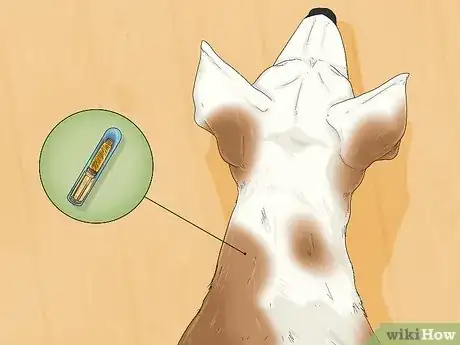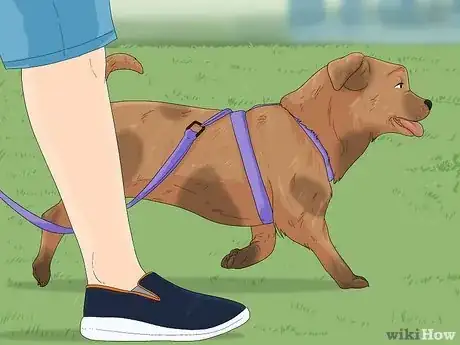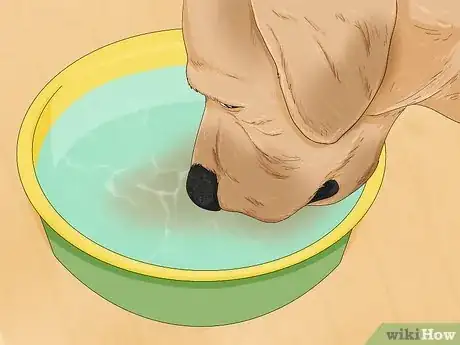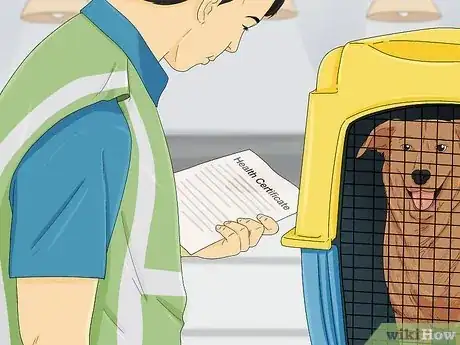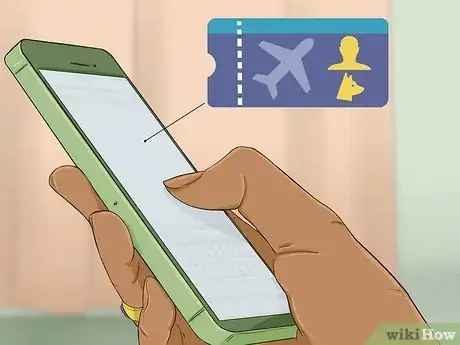This article was co-authored by Cameron Thompsen. Cameron Thompsen is a Dog Trainer and Human Coach, as well as the Owner and Founder of Hope2K9 Foundation. With nearly two decades of experience, she specializes in working with dogs and their owners on behavior issues ranging from severe anxiety, reactivity, as well as aggression and fear-based problems. She works with all dogs at Hope2K9 so that they are fully trained before adoption, and provides lifelong support to dog owners after adoption.
There are 10 references cited in this article, which can be found at the bottom of the page.
This article has been viewed 64,034 times.
Flying with your furry friend is certainly possible, but it takes some preparation. You will need to contact the airline and book your dog in advance, the same way you do for yourself. You will also need to make sure your dog is used to their carrier and the chaos of travel. On the day of the flight, make sure your pet has access to food and water and try to keep things as calm as possible for it. By getting all of this together before you leave, you can ensure a safe and easy flight for you and your dog.
Steps
Getting Your Dog Ready to Fly
-
1Check to make sure your dog should be flying. Not all dogs are considered safe to fly. In general, airlines do not recommend that puppies under 8 weeks, elderly dogs, or sick dogs fly either in-cabin or as cargo. Short-nosed dogs, such as bulldogs and pugs, are not good candidates for being checked as they run the risk of overheating. Do not risk your dog’s health and safety by having it fly when it is not fit to do so.[1]
- Remember that your dog will also be handled either by airport security or the crew loading the checked bags. If your dog is not friendly toward strangers, it should not fly. Even a small bite can land both you and it in big trouble.
-
2Introduce your dog to their carrier weeks before your flight. Get your dog comfortable with the carrier in which it will fly as far in advance as you can.[2] If your dog is already crate trained, it just needs to get used to the feel and smell of the carrier. Leave the carrier out with the door open so that your dog can explore it. Then try putting your dog in the carrier and leaving the room a few times to make sure it stays calm.[3]
- Line the bottom of the crate with a blanket or towel to keep your dog warm and cozy, and to absorb any in-flight accidents. If you can, use its favorite one. It will smell like home, which may help calm your dog.
- If your dog is not crate trained, start the training process. It will need to be comfortable being left alone in their crate without panicking or frequently going to the bathroom.
- Even dogs flying in-cabin need to stay under the seat, so it needs to be comfy in its crate.
Advertisement -
3Make sure your dog is comfortable being handled in its carrier. Once your dog is comfortable in their crate, help it adjust to new sounds and motions. Try taking it for a car ride while it is in their carrier. This can help it get used to the motion of transport. [4]
- If you can, have friends and family carry your dog in their carrier to get it used to other people handling it.
-
4Play recordings of airport sounds to get it used to new noises. Desensitize your dog to the noises of the airport by playing recordings of crowds and planes taking off and landing. Play these tracks a few times a week in the weeks leading up to your flight. You can find recordings of crowds and airport noises on websites such as Youtube.[5]
- Getting your dog acquainted with new sounds in advance will help keep it from panicking when you get to the airport.
-
5Call your vet to see if you need a travel health certificate. In some cases, you will need a vet clearance to travel. These can include checking your pet as cargo or flying your pet to an international destination. Different locations have different requirements and agreements, so call your vet to see what is necessary for your dog. They will be able to help you figure out if your dog needs any new vaccines or boosters. They can also sign any paperwork required by your destination.[6]
- If your dog needs a vet check, try to do this around 45 days before your departure, or at the time specified by the travel certificate. You need at least 30 days for a rabies vaccine to take effect, but getting checked too early could make some tests invalid.
- Make at least two copies of your dog’s paperwork to take with you when you travel. Keep one copy with your boarding documents and tape on your dog's carrier.
-
6Ask your vet about sedation if your dog doesn't like traveling. In most cases, an unsedated dog is a safer traveler since its senses are still sharp. If your dog struggles traveling, though, it may be a good candidate for a sedative. Your vet will be able to prescribe the right sedative at the right dose for your pet.[7]
- Some factors that can make dogs uncomfortable traveling include motion sickness, separation anxiety, or panicking when it meets new people.
- Some dogs may not require a prescription sedative, and may instead be fine with an over-the-counter calming supplement. You should still consult your vet prior to giving your dog any medications or supplements for the first time.[8]
- If your dog has never taken the prescribed sedative before, talk to your vet about getting an extra dose or half dose so that you can test it in advance. This will let you see if your dog has any adverse reactions before traveling.
-
7Get your dog microchipped in case it gets lost. If your dog escapes and runs off in a busy airport, you'll want a quick and reliable way to get it back. Ask your veterinarian about getting a microchip implanted a few weeks before you leave.
- If your dog is lost, vets and authorities will be able to scan the microchip and get information to contact your microchip's registry, where they can get your phone number.[9]
Traveling With Your Dog
-
1Take your dog for a walk before you leave for the airport. Your dog is likely going to be in their carrier for at least a few hours. Allow it to stretch and burn off some energy before it has to go into the carrier.[10] Take it for a walk, run, jog, or long play session at the dog park right before you leave the house.
-
2Feed your dog as regularly as possible throughout the day. Try to stick to your dog’s regularly scheduled meal times as closely as possible. Bring a dish and a day’s worth of food with you in your carry-on. Take some time before you leave as well as after you check in to make sure your dog is eating regularly.[11]
- Try not to feed your dog for at least 3 hours before taking off unless it is medically necessary. This will give it time to digest and help avoid accidents on the flight.[12]
- If you are checking your dog, you will need to provide a food dish clipped onto the carrier door, and a bag of food taped to the outside of the carrier. This way, airline employees can feed your dog without reaching in the crate.
- If you plan on traveling with your dog often, you may want to invest in a collapsible dog dish. These are lightweight, take up minimal space, and are easy to clean on-the-go.
-
3Give your dog water throughout the day. Your dog should have access to clean, fresh water as much as possible during the day. You can clip a water bowl to the inside of the carrier, or you hold the bowl for your dog to let it drink if the carrier is too small.[13]
- If you are holding the bowl, try to make sure you give your dog a chance to drink at least every half hour before the flight.
- Checked carriers will be required to have a water bowl attached. The bowl may be empty for the ride to the airport and in transit down to the loading area, but it should be full the rest of the time.
-
4Check in your dog at the ticket counter. You can check in online prior to your flight, but you will still need to check in your pet at the ticket counter. The ticket agent will print tags for your pet’s carrier, clearing it to go past security or get dropped off at cargo. Be ready to pay the pet fee at this time.[14]
- Try to get to the airport at least one hour earlier than recommended by the airline. This will give you ample time to check-in and help minimize stress.
-
5Take your dog for a final bathroom break before security. Before you go through security or over to cargo, take your dog to the airport pet relief area. This gives it a chance to take one last bathroom break. Try to do this after you check in but before you go through security. This helps ensure that your dog goes as close to take off as possible.[15]
- If you are unsure about where the pet relief area is located, ask an airport employee.
- Some airports have pet relief areas inside the terminal, past security. You can check online in advance to see if your departing airport has an in-terminal relief area, but you should not count on this.
-
6Have an employee show you the cargo loading area for large carriers. If you are checking your pet, you will drop it off directly at the airline’s cargo facility. You will also pick it up there on the other end. Ask an airline representative where you should drop off your dog if it is checked.[16]
- You can ask to watch boarding from the terminal or jetway to make sure your pet is properly handled before you board.
- Double check to make sure that your dog’s health certificate is thoroughly fastened to the side of the crate and that their ID tag is secure on their collar before you drop it off.
Making Arrangements for Your Dog
-
1Call your airline to confirm they are pet friendly. Some airlines don’t allow dogs, while others have size restrictions that dictate how your dog can travel. Call your airline or check their website to see if they allow pets.[17]
- If the airline does allow pets, check their size limits. Most pet-friendly airlines allow dogs to fly in the cabin if it is small enough to go in a carrier that will fit under the seat in front of you. For larger dogs, you will likely have to check it as baggage or cargo.
- If you have to check your dog, remember that this means your pet will be separated from you for hours, handled repeatedly, and be exposed to a new, loud, crowded environment. Subsequently, checking your dog can be extremely stressful for both it and you.[18]
-
2Add your dog to your ticket before your departure date. Airlines often have a limit to the number of pets they allow per flight, so you are required to add your pet to your ticket in advance. If you buy your ticket over the phone, let your representative know when you book that you will bring a pet. If you book online, call customer service after you’ve completed your purchase.[19]
- Most airlines don’t have the option to add a pet if you are purchasing a ticket online. You will need to call their customer support line.
- In most cases, airlines will notify you of the pet fee over the phone. You won’t be expected to pay until you check in at the counter, though.
-
3Check your carrier to make sure it is compliant. Different airlines will have different requirements regarding how small carriers need to be for in-cabin travel. They will also have rules for the size and materials of carriers that get checked. Call your airline or check on their website to get a full list of their requirements. Check your carrier to make sure it is compliant with your airline’s regulations. If it is not, buy a compliant carrier before your departure date.[20]
- Most airlines will require that a dog must, at a minimum, be able to stand up, sit down, and turn around completely in a carrier, regardless of whether it’s being checked or carried on.
- While soft-sided carriers are generally permissible for in-cabin travel, they cannot be checked. Checked carriers will need to be made of a hard material such as plastic, and have ventilation built-in.
- Some airlines sell pet carriers through their catalogs or online stores. These are generally pre-checked for compliance by the airline. Just remember that different airlines have different requirements, so a carrier from one airline may not be compliant with all airlines.
Expert Q&A
-
QuestionShould I feed my dog before flying?
 Pippa Elliott, MRCVSDr. Elliott, BVMS, MRCVS is a veterinarian with over 30 years of experience in veterinary surgery and companion animal practice. She graduated from the University of Glasgow in 1987 with a degree in veterinary medicine and surgery. She has worked at the same animal clinic in her hometown for over 20 years.
Pippa Elliott, MRCVSDr. Elliott, BVMS, MRCVS is a veterinarian with over 30 years of experience in veterinary surgery and companion animal practice. She graduated from the University of Glasgow in 1987 with a degree in veterinary medicine and surgery. She has worked at the same animal clinic in her hometown for over 20 years.
Veterinarian Avoid feeding immediately before boarding, as the dog will have a full stomach. However, a totally empty stomach can also cause nausea. A good compromise is to give a light meal an hour or so before loading so the dog isn't overly hungry but doesn't have a full belly.
Avoid feeding immediately before boarding, as the dog will have a full stomach. However, a totally empty stomach can also cause nausea. A good compromise is to give a light meal an hour or so before loading so the dog isn't overly hungry but doesn't have a full belly. -
QuestionCan I sedate my dog for air travel?
 Pippa Elliott, MRCVSDr. Elliott, BVMS, MRCVS is a veterinarian with over 30 years of experience in veterinary surgery and companion animal practice. She graduated from the University of Glasgow in 1987 with a degree in veterinary medicine and surgery. She has worked at the same animal clinic in her hometown for over 20 years.
Pippa Elliott, MRCVSDr. Elliott, BVMS, MRCVS is a veterinarian with over 30 years of experience in veterinary surgery and companion animal practice. She graduated from the University of Glasgow in 1987 with a degree in veterinary medicine and surgery. She has worked at the same animal clinic in her hometown for over 20 years.
Veterinarian If the dog is traveling in the hold, then sedation is not advisable. Sedation can make it difficult for the dog to control their body temperature, making them prone to chilling which has the potential to be dangerous.
If the dog is traveling in the hold, then sedation is not advisable. Sedation can make it difficult for the dog to control their body temperature, making them prone to chilling which has the potential to be dangerous. -
QuestionHow can I help my dog after flying?
 Cameron ThompsenCameron Thompsen is a Dog Trainer and Human Coach, as well as the Owner and Founder of Hope2K9 Foundation. With nearly two decades of experience, she specializes in working with dogs and their owners on behavior issues ranging from severe anxiety, reactivity, as well as aggression and fear-based problems. She works with all dogs at Hope2K9 so that they are fully trained before adoption, and provides lifelong support to dog owners after adoption.
Cameron ThompsenCameron Thompsen is a Dog Trainer and Human Coach, as well as the Owner and Founder of Hope2K9 Foundation. With nearly two decades of experience, she specializes in working with dogs and their owners on behavior issues ranging from severe anxiety, reactivity, as well as aggression and fear-based problems. She works with all dogs at Hope2K9 so that they are fully trained before adoption, and provides lifelong support to dog owners after adoption.
Dog Trainer Avoid cuddling and comforting it right away. When you share affection, you're reinforcing the stress and anxiety that the dog is probably already feeling. So it's best to actually take them for a walk, get them to move on from that experience and move their body.
Avoid cuddling and comforting it right away. When you share affection, you're reinforcing the stress and anxiety that the dog is probably already feeling. So it's best to actually take them for a walk, get them to move on from that experience and move their body.
Warnings
- Dogs or any other pets are not allowed to travel with unaccompanied minors on flights.⧼thumbs_response⧽
Things You'll Need
- Pet carrier that fits regulations
- Leash & collar
- Recent picture of your dog
- Dog food
- Towels for the inside of your dog's carrier
- Two bowls for the inside of your carrier
- Health certificate from your veterinarian
References
- ↑ http://www.vetstreet.com/our-pet-experts/how-can-we-make-flying-with-our-dog-easier
- ↑ Cameron Thompsen. Dog Trainer. Expert Interview. 31 March 2022.
- ↑ https://www.rover.com/blog/how-to-fly-with-a-dog/
- ↑ https://www.whole-dog-journal.com/issues/17_5/features/Preparing-to-Fly-With-Your-Dog_20975-1.html
- ↑ https://www.rover.com/blog/how-to-fly-with-a-dog/
- ↑ https://www.cdc.gov/features/travelwithpets/index.html
- ↑ http://www.vetstreet.com/our-pet-experts/how-can-we-make-flying-with-our-dog-easier
- ↑ Cameron Thompsen. Dog Trainer. Expert Interview. 31 March 2022.
- ↑ http://www.humanesociety.org/animals/resources/tips/microchips.html
- ↑ Cameron Thompsen. Dog Trainer. Expert Interview. 31 March 2022.
- ↑ http://www.vetstreet.com/our-pet-experts/how-can-we-make-flying-with-our-dog-easier
- ↑ Cameron Thompsen. Dog Trainer. Expert Interview. 31 March 2022.
- ↑ https://www.rover.com/blog/how-to-fly-with-a-dog/
- ↑ https://tractive.com/blog/en/good-to-know/how-to-prepare-your-dog-for-air-travel
- ↑ https://tractive.com/blog/en/good-to-know/how-to-prepare-your-dog-for-air-travel
- ↑ http://www.pettravel.com/passports_airlinetrtips.cfm
- ↑ https://www.whole-dog-journal.com/issues/17_5/features/Preparing-to-Fly-With-Your-Dog_20975-1.html
- ↑ https://www.smithsonianmag.com/travel/is-taking-your-pet-on-an-airplane-worth-the-risk-6241533/
- ↑ https://www.whole-dog-journal.com/issues/17_5/features/Preparing-to-Fly-With-Your-Dog_20975-1.html
- ↑ http://www.pettravel.com/airline-pet-carriers.cfm
About This Article
To prepare a dog for air travel, introduce it to its carrier weeks in advance so your dog can get used to how it feels and smells. As it gets more comfortable, put it in the carrier and drive it around so it’s used to travel, and have friends carry it so it’s used to being handled by others. You should also play airplane noises around it multiple times leading up to the flight. Finally, feed your dog on its normal schedule, and take it for a walk and bathroom break as close to the flight as possible. For advice from our Veterinary reviewer on how to register your pet with the airline, read on!




